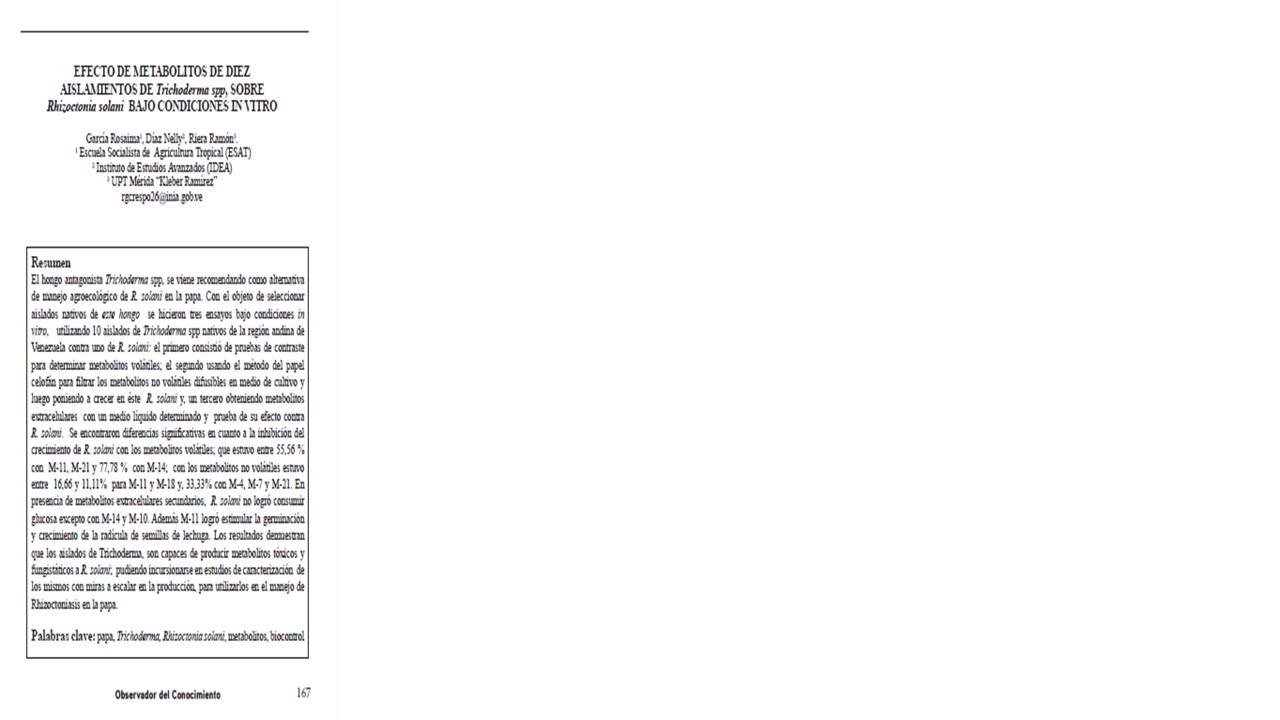Effect of Metabolites of Ten Isolations of Trichoderma SPP, Envelope Rhizoctonia Solani under Conditions In Vitro
Keywords:
Potato, Trichoderma, Rhizoctonia solani, metabolites, biocontrolAbstract
The antagonist fungus Trichoderma spp. Has been recommended as an alternativ for agroecological management of R. solani in potatoes. In order to select native isolates of this fungus, three trials were conducted under in vitro conditions, using 10 isolates of Trichoderma spp native to the Andean region of Venezuela against one of R. solani: the first consisted of contrast tests to determine volatile metabolites; the second using the cellophane paper method to filter the non-volatile metabolites diffusible in culture medium and then growing R. solani in it, and a third obtaining extracellular metabolites with a determined liquid medium and proof of their effect against R. solani.
Downloads
References
Cardoza, R.; Hermosa, M.; Vizcaíno, J.; Sans, L.; Monte, E.; Gutiérrez, S. (2005). Secondary metabolites produced by Trichoderma and their importance in the biocontrol process. En Microorganism for industrial enzymes and biocontrol. Mellado E. y Barredo J. L(eds). Reseachs Signpost, Kerala, India. pp. 1-22.
Dennis, C.; Webster, J. (1971). Antagonist properties of species-groups of Thichoderma. I. Production of non volatile antibiotics. Trans. Brit Mycol. Soc. 57:25-39.
Dennis, C.; Webster, J. (1971). Antagonist properties of species-groups of Thichoderma. II. Production of volatile antibiotics. Trans. Brit Mycol. Soc. 57:47-4.
Fraga, B.; Hernández, M.; González, M.; Garbarino, J. (2000). The biotransformation of 18-Hidroxy-9- epi-ent-pimara-7,15diene by Gibberella fujikuroi. Phytochem 53:395-399.
García, R.; García, A.; Garnica, J. (2002). Distribución, Incidencia y Alternativas de Control de Rhizoctonia solani en el cultivo de la papa en el estado Mérida, Venezuela. Revista Latinoamericana de la papa. 13(1): 24-40.
García, R.; Salas, J.; Ramos, G. (2005). Producción de semilla de papa en Venezuela. Serie manuales de cultivo, INIA Nº5.
Harman, G.E. (2004). Mythos and dogmas of biocontrol. Changes in perceptions derive from research on Trichoderma harzianum T22. Plant Dis.84:377-393.
Harman, G.E. (2006). Overview of mechanisms and uses of Trichoderma spp. Phytopathology. 96: 190
-194.
Howell, C.R. (2003). Mechanisms employed by Trichoderma species in the biological control of plant diseases: The history and evolution of current concepts. Plant Disease. 87(1): 4-10.
Reino, J. L.; Guerrero, R. F.; Hernández- Galán, R.; Collado, I. (2008). Secundary metabolites from species of the biocontrol agent Trichoderma. Phytochem Rev. 7: 89-123.
Sivan, A.; Elad Y.; Chet, I. (1984). Biological Control Effects of New isolate of Trichoderma
harzianum on Pythium aphanidermatum. Phytopathology .74: 498-501.
Tudzynski, B. (1999). Biosynthesis of gibberellins in Gibberella fujikuroi: biomolecular aspects. Appl. Microbiol Biotechnol. 52: 298-310.
Vinale, F.; Marra, R.; Scala, F.; Ghisalberti, E. ; Lorito, M.; Sivasithamparam, K. (2006). Major secondary metabolites produced by two commercial Trichoderma strains active against different phytopathogens. Lett Appl. Microbiol. 43: 143-148.
Weindling, R. (1934). Studies on lethal principles effective in the parasitic action of Trichoderma lignorum on Rhizoctonia solani and other soil fungi. Phytopathology 24: 1153-1179.
Weindling, R.; Emerson, O. (1936). The isolation of a toxic substance from the culture filtrate of a Trichoderma. Phytopathology. 26: 1068-1070.

Downloads
Published
How to Cite
Issue
Section
License

This work is licensed under a Creative Commons Attribution-NoDerivatives 4.0 International License.







